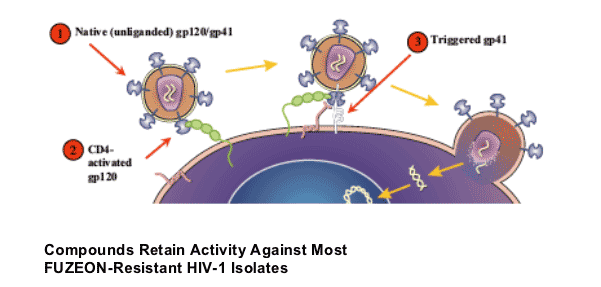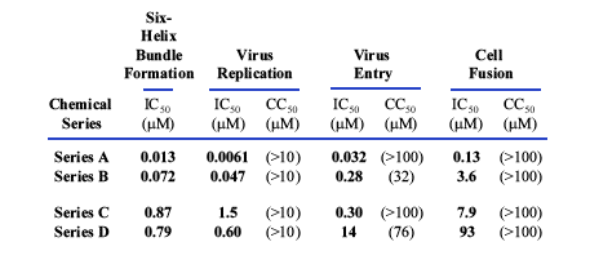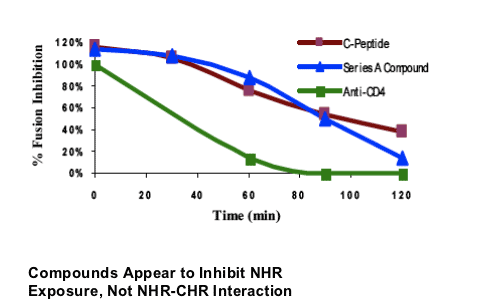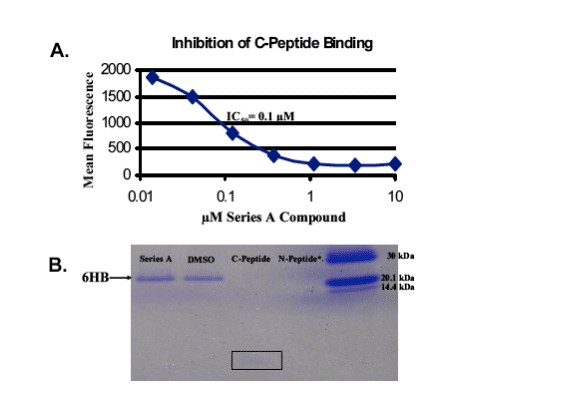 |
 |
 |
| |
Panacos Fusion Inhibitor Drug Discovery Program: developing oral fusion inhibitor active against Fuzeon resistance
|
| |
| |
Panacos has identified several compounds that appear to have a novel mechanism of action that work at blocking fusion at a different step of the fusion process than Fuzeon.
Reported by Jules Levin
XVI IAC Toronto, Aug 2006
"Validation of a Novel Approach for HIV-1 Fusion Inhibitor
Drug Discovery"
Poster No.THPE0022
C. Finnegan, I. Burimski, T. Jackson, A. Castillo, N. Kilgore, M. Reddick, A. Yunus, M. Zuiderhoff, T. Nitz,
C. Wild, G. Allaway, and K. Salzwedel. Panacos Pharmaceuticals, Gaithersburg, MD, USA.
Author Summary
- We have used a novel screening assay to identify small molecule HIV-1 fusion inhibitors that block gp41 six-helix bundle formation. However, unlike peptide-based fusion inhibitors, the small molecule inhibitors described here appear to act upstream of exposure of the gp41 prehairpin intermediate and are active against most FUZEON-resistant virus isolates.
- These compounds specifically inhibit HIV-1 entry and replication in vitro with nanomolar potency.
-Preliminary pharmacokinetic studies with Series B compounds have demonstrated up to 30% oral bioavailability in rats, thus validating this approach for identifying orally bioavailable HIV-1 fusion inhibitors.
- Hit-to-lead optimization of these compounds, as well as high-throughput screening of additional compound libraries is ongoing.
ABSTRACT
BACKGROUND: Fusion inhibitors are a promising new class of HIV therapeutics that block conformational changes in the HIV envelope glycoprotein (Env). Proof of concept for this therapeutic approach is provided by the approved drug, FUZEON, a peptide-based inhibitor that must be injected and is expensive to manufacture. The identification of small molecule fusion inhibitors with oral bioavailability would provide new therapeutic options for the treatment of HIV/AIDS. Here we validate a novel approach for the discovery of small molecule HIV fusion inhibitors with unique mechanisms of action.
METHODS: A novel cell-based high-throughput HIV fusion inhibitor assay was employed to screen diverse libraries of over 200,000 drug-like small molecules. This assay identifies compounds that block conformational changes within Env that are critical for membrane fusion. Hits from the primary screen were confirmed in functional assays measuring inhibition of Env-mediated membrane fusion, virus entry, and virus replication.
RESULTS: Using this approach we have identified several structurally distinct families of drug-like small molecules that specifically inhibit HIV-1 infection with nanomolar potency. The effects of a subset of these compounds on HIV fusion were studied using time-of-addition and flow cytometry experiments. Such studies suggest that these compounds, unlike other classes of fusion inhibitors, bind to HIV Env prior to CD4 binding and specifically block receptor-induced conformational changes that occur after exposure of the coreceptor binding site in gp120, but before exposure of the target for Fuzeon. As a result, Env is unable to form the critical six-helix bundle (6HB) structure that is required for fusion.
CONCLUSIONS: These results validate this approach for identifying small molecule HIV fusion inhibitors with novel mechanisms of action. The compounds identified in this study are currently being optimized for drug development and may lead to attractive therapeutic alternatives to peptide-based fusion
Introduction
During virus entry, the HIV-1 envelope glycoprotein (Env) undergoes a complex series of conformational changes induced by interactions with CD4 and coreceptor on the target cell surface (Fig. 1). These conformational changes culminate in the formation of a six-helix bundle structure in the gp41 transmembrane subunit (Fig. 2A). The formation of this structure drives fusion of the viral and target cell membranes. These conformational changes present attractive targets for drug discovery.
Figure 1: HIV fusion inhibitor targets. Drug targets on HIV Env can be
classified into three groups: 1) Those that are present in native gp120 and gp41. 2) Those exposed in gp120 following CD4 binding. 3) Those exposed in triggered gp41 (as in T-20 peptide inhibition).

Table 2: Compounds have a resistance profile distinct from that of Cpeptide inhibitors. Infectivity of Fuzeon-resistant HIV-1NL4-3 was determined by single-round infection assays in HeLa-CD4-LTR-_-gal cells in the presence of inhibitor. C34 is a C-peptide inhibitor similar to FUZEON. All viruses were normalized for MOI, and infection was quantitated by _-galactosidase readout. Activity against viruses resistant to the other classes of HIV drugs is expected based on the novel mechanism of action of these compounds, and these experiments are in progress.

We developed a proprietary high-throughput screening assay for the identification of inhibitors of Env conformational changes necessary for membrane fusion and virus entry. This method employs antibodies specific for the gp41 six-helix bundle (6HB) structure to detect receptor-triggered Env conformational changes (Fig. 2).
Compounds that inhibit the conformational changes in either gp120 or gp41 that are a prerequisite for six-helix bundle formation and fusion are identified by a reduction in antibody binding to Env-expressing cells following triggering.
High-Throughput Screening Campaign
A diverse library of over 200,000 drug-like compounds was screened in the six-helix bundle inhibition assay. A screening algorithm was employed to identify specific fusion inhibitors (Fig. 3).

Several structurally distinct families of fusion inhibitors have been identified using this screening approach. Hit-to-lead optimization is ongoing for the most promising compounds. Here we describe the characterization of a subset of these compounds that represent a new class of fusion inhibitors with a novel mechanism of action. The molecular weights of these compounds range from 360 to 560 (mean = 425), with cLogP values ranging from 2.5 to 5.6 (mean = 3.7).
Table 1: Characterization of representative compounds from four
chemically distinct series of small molecule HIV fusion inhibitors with
similar mechanisms of action. Series A and B have undergone partial hit-tolead optimization; whereas, Series C and D are original hit compounds. Six-helix bundle formation on the surface of Env-expressing cells was measured by FACS using antibodies specific for the 6HB structure. HIVRF replication in U87-CD4-CXCR4 cells was quantitated by p24 ELISA on either day 5 or day 7 with daily drug replenishment. Virus entry (single-cycle infection) and cell-cell fusion assays were performed using HeLa-CD4-LTR-_-gal indicator cells.

Previously we demonstrated that this novel class of fusion inhibitors affected gp120 conformation by binding to native Env prior to receptor engagement. Here we extend these results to show that the compounds can continue to bind up to a late stage in HIV fusion and apparently inhibit exposure of the Nhelical coiled-coil, to which C-peptide inhibitors bind. We further demonstrate that these compounds have a resistance profile distinct from that of C-peptide inhibitors. Thus, these compounds appear to block HIV fusion by interacting with a
unique target in Env. Results from the characterization of the mechanism of action of partially optimized compounds from Series A and B are shown.
These results are representative of those obtained with compounds from the four chemically distinct series listed above (A, B, C, and D; data not shown).
Compounds Inhibit Post-CD4 Binding
Figure 4: Compounds do not inhibit CD4-gp120 binding and target a
post-CD4 engagement step. (A) H9 cells were pre-incubated with a Series A
compound, small molecule attachment inhibitor, or anti-CD4 Mab for 30 min. gp120 was then added for 30 min at 37°C, followed by HIVIG for 45 min. HIVIG binding was quantitated by flow cytometry. (B) Env-expressing cells were pre-incubated with either compound or sCD4 for 1h at 4°C. Following washout of the initial reagent, sCD4 was added to cells that had previously received compound, and compound was added to the cells that had received sCD4. The binding of six-helix-bundle-specific antibodies at 37°C was then quantitated by flow cytometry.

Figure 5 : Temporal analysis of fusion inhibition with a Series A
compound. Compound was added either at time 0, or 30-120 minutes after coculture of virus and cells. The anti-CD4 Mab and C-peptide (C34; similar to FUZEON) were used as controls to determine the kinetics of virus-CD4 attachment and 6HB resolution, respectively.

Figure 6 : Compound inhibits C-peptide binding to gp41, but does not
inhibit N-peptide/C-peptide interaction.
A) A Series A compound inhibited the binding of C-peptide to cell-surface-expressed Env following incubation with sCD4 at 37°C. C-peptide (C34) was detected by flow cytometry using T26 Mab. B) 6HB formation can be detected by Native-PAGE as a molecular weight shift following N- and C-peptide interaction. N36 peptide (40 _M) was incubated with DMSO or compound (850 _M) at 37°C for 30 min before addition of C34 peptide (40 _M). Migration rates were compared with C-peptide alone. No effect of the compound on peptide-peptide association was observed. * N-peptide is not visualized due to its net positive charge (peptide migrates off top of gel).

Compounds Target a Late Step in HIV-1
Fusion Similar to C-Peptide Inhibitors
|
| |
|
 |
 |
|
|